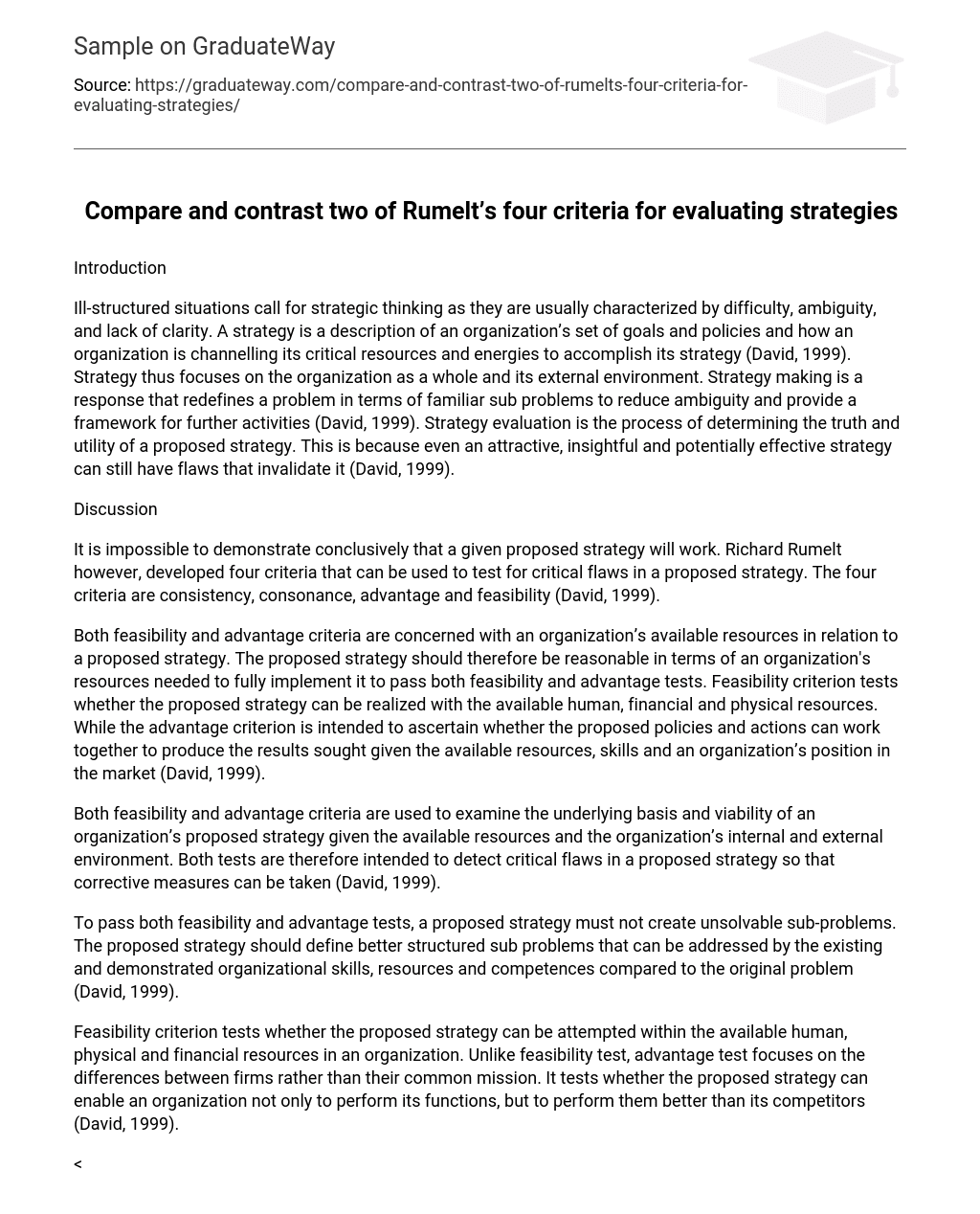Introduction
Ill-structured situations call for strategic thinking as they are usually characterized by difficulty, ambiguity, and lack of clarity. A strategy is a description of an organization’s set of goals and policies and how an organization is channelling its critical resources and energies to accomplish its strategy (David, 1999). Strategy thus focuses on the organization as a whole and its external environment. Strategy making is a response that redefines a problem in terms of familiar sub problems to reduce ambiguity and provide a framework for further activities (David, 1999). Strategy evaluation is the process of determining the truth and utility of a proposed strategy. This is because even an attractive, insightful and potentially effective strategy can still have flaws that invalidate it (David, 1999).
Discussion
It is impossible to demonstrate conclusively that a given proposed strategy will work. Richard Rumelt however, developed four criteria that can be used to test for critical flaws in a proposed strategy. The four criteria are consistency, consonance, advantage and feasibility (David, 1999).
Both feasibility and advantage criteria are concerned with an organization’s available resources in relation to a proposed strategy. The proposed strategy should therefore be reasonable in terms of an organization’s resources needed to fully implement it to pass both feasibility and advantage tests. Feasibility criterion tests whether the proposed strategy can be realized with the available human, financial and physical resources. While the advantage criterion is intended to ascertain whether the proposed policies and actions can work together to produce the results sought given the available resources, skills and an organization’s position in the market (David, 1999).
Both feasibility and advantage criteria are used to examine the underlying basis and viability of an organization’s proposed strategy given the available resources and the organization’s internal and external environment. Both tests are therefore intended to detect critical flaws in a proposed strategy so that corrective measures can be taken (David, 1999).
To pass both feasibility and advantage tests, a proposed strategy must not create unsolvable sub-problems. The proposed strategy should define better structured sub problems that can be addressed by the existing and demonstrated organizational skills, resources and competences compared to the original problem (David, 1999).
Feasibility criterion tests whether the proposed strategy can be attempted within the available human, physical and financial resources in an organization. Unlike feasibility test, advantage test focuses on the differences between firms rather than their common mission. It tests whether the proposed strategy can enable an organization not only to perform its functions, but to perform them better than its competitors (David, 1999).
Feasibility test is largely based on a firm’s internal assessment. It assesses an organization’s internal environment like available resources and employees skills to ascertain whether they can support the realization of a proposed strategy. On the other hand advantage test is largely based on a firm’s external assessment. It assesses an organization’s external environment like competitors to ascertain whether the proposed strategy can create and/or maintain a competitive advantage in terms of superior resources, superior skills and superior position (David, 1999).
The feasibility criterion is addressed in planning documents and procedures. The evaluation is performed using a variety of tools, theories and methods. For example predicting outcomes associated with particular actions using trend analysis tools. On the other hand advantage criterion evaluation is based on an organization’s culture and strategic plans to ensure that the proposed strategy is in line with the organization’s culture and strategic plans put in place to gain competitive advantage over competitors (David, 1999).
Conclusion
An organization’s internal and external environment is always changing. To survive in this volatile environment, an organization needs to adjustment its strategies to the changing situations. This is because even best conceived and implemented strategies become obsolete with time. Rumelt four criteria are therefore useful for testing critical flaws in a proposed new strategy.
Reference
David, F. R. (1999). Strategic management: Concept (7th ed.). Upper Saddle River, NJ: Prentice-Hall press.





